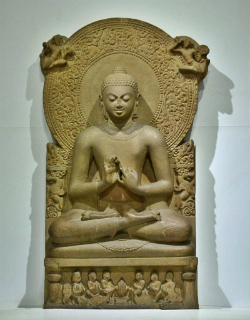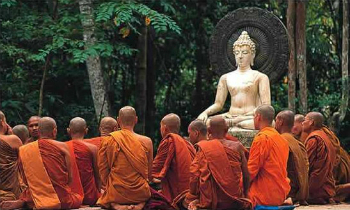Buddhism is a philosophical and spiritual doctrine, which emerged in India in the 19th century. Via. Ç. and its precept is the search for the end of human suffering and thus, attaining enlightenment.
Its principles are based on the teachings of Siddhārtha Gautama, known as Buddha, which means "Awakened" or "Enlightened".
Buddhists, therefore, do not worship a god or gods, nor do they have a rigid religious hierarchy, being much more an individual pursuit when compared to monotheistic western religions.
Characteristics of Buddhism
Buddhism is characterized by a series of teachings that guide the human being to let go of all defects proper to humanity such as anger, jealousy, envy to develop qualities such as love, generosity, wisdom etc.
Buddhism, therefore, is an attitude towards the world, as its followers learn to let go of everything that is transitory, which results in a kind of spiritual self-sufficiency.
In the Buddhist universe, which has no beginning or end, Nirvana would be the ideal stage, but it cannot be taught, only perceived.
Karma is a prominent subject in Buddhism. According to this idea, good and bad actions (arising from mental intention) will bring consequences in the next rebirths. In each of them, the being will have the opportunity to let go of everything that prevents him from reaching perfection.
Therefore, rebirth, a process in which we go through successive lives, is precisely the cycle where one seeks to break through suffering in order to ascend to the purest dwellings. This vicious cycle of suffering is called "Samsara" and is governed by the laws of Karma.
Thus, the intended path in Buddhism is the “Middle Way”, that is, the practice of non-extremism, both physical and moral.
Buddha
O Buddha it is not for the followers of the doctrine a particular being, but a title given to a Buddhist teacher or to all those who have attained the spiritual realization of Buddhism. Thus, Buddha in Hindu means "the Enlightened One" or "the awakened one".
The first Buddha was Siddhartha Gautama, a prince of the Sakia dynasty in India, who left everything to devote himself to spiritual life. Born in 563 a. Ç. his life is summed up by his followers in birth, maturity, renunciation, seeking, awakening and deliverance, teaching and death.

Statue of Siddhartha Gautama
Siddhārtha Gautama was raised surrounded by luxury, married and had a child, but in his youth he discovered the reality of human suffering and was shocked. He met four people: an elderly woman, a sick person, a dead person, and finally an ascetic, and he asked himself about the origin of it all.
However, it was when he met this religious ascetic, who was mortifying himself in strict fasting, that he thought that there was the answer to his questions. So he shaved his head in humility, exchanged his sumptuous clothes for the unassuming orange outfit, and launched himself into the world in search of explanations for the enigma of life.
After seven years of deprivation, Gotama chose the shadow of a sacred fig tree and began to meditate, remaining so until all his doubts were cleared up.
During this time, the spiritual awakening he had been looking for took place. Enlightened by a new understanding of all things in life, he headed for the city of Benares, on the banks of the Ganges River. His idea was to convey to others what had happened to him.
Origin of Buddhism
Buddhism is born when Siddhārtha Gautama decides to share with others his path to reach the end of suffering.
His doctrine blends with the beliefs of Hinduism, making it a philosophy that easily adapted to each region where it settled, as well as to each human being who wished to learn it.
In the 45 years that he preached his doctrine, all over India, the Buddha always mentioned the "Four Truths" and the "Eight Paths".
Furthermore, he summarized his thinking in the Golden Rule:
"Everything we are is the result of what we think".
Only centuries after his death a meeting was held that defined the Buddhist precepts, where two great schools prevailed: Theravada and Mahayana.
Teachings of Buddhism

Buddhist Monks
Gautama's teachings, delivered in the city park of Benares, defined the paths to be followed to reach the wisdom of moderation and equality.
According to Buddhism, there are Four Truths:
1. life is suffering;
2. suffering is the fruit of desire,
3. it ends when the desire ends,
4. it is achieved by following those taught by the Buddha.
With these "Four Noble Truths", man has the basic elements to take the "Path of the Eight Paths".
From him they will demand purity of faith, will, language, action, life, application, memory and meditation.
From the third and fourth tracks, the followers of Buddha extracted five precepts, similar to the Jewish commandments. Christian, because they advised not to kill, not to steal, not to commit impure acts, not to lie and not to drink liquids intoxicating.
Buddhist schools
Four are the best known Buddhist schools:
- Nyingma
- Kagyu
- Sakya
- Jellybean
The path of liberation through the Three Jewels prevails in them:
- The Buddha as a guide;
- Dharma as the fundamental law of the universe;
- The Sangha as the Buddhist community.
The expansion of Buddhism
During the three centuries that followed the death of Gautama, Buddhism spread throughout ancient India. He ended up having more supporters than the Hinduism, the traditional religion of the country.
But after spreading across Asia, it disappeared from the country of origin, giving way to Hinduism. In the course of expansion, taken by the silk trade route, it crossed the entire Orient.
The original doctrine differed, became less rigorous, adapted to the spiritual needs of simple people. This form of Buddhism was called mahayana, or "larger vehicle".
In Tibet, the doctrine merged with the ancient religion good po, deriving later to the lamaism.
In Burma, Thailand, Laos, Cambodia, Ceylon and Vietnam, Buddhism remained orthodox, being called hinayana, or the "smaller vehicle".
Gradually, Chinese pilgrims and Hindu Buddhist monks began to cross the mountains as missionaries.
One of the pilgrims, Hsuan-Tsang (or Xuanzang), left China in 629, crossed the Gobi Desert and reached India. There, for 16 years he collected data on Buddhism and wrote, according to tradition, more than a thousand volumes.
China was ruled by the Tsang dynasty and thousands of people converted to Buddhism.
Among other religions, the Confucianism, O Taoism, O Zoroastrianism, Buddhism was the one that presented the most profound concepts and over time it branched out into many sects.
Around the 7th century, Buddhism arrived in Korea and Japan, which after the conversion of Prince Shotoku Taishi, became a national religion.
In the following century, Buddhism arrived in Tibet, but already quite changed. It was introduced by Padma Sambhava, a Hindu Buddhist monk.
The official religion was already in open decay. It easily merged with the new concepts and the lamaism. This turned Tibet into a theocratic state, ruled by the Dalai and Panchen Lamas - lamaist monks considered reincarnation of sanctities.
Buddhism entered Europe in 1819, where the German Arthur Schopenhauer developed new concepts, very close to Buddhism.
In 1875 the Theosophical Society was founded, which encouraged research into Asian religions.
Buddhism has expanded around the world and there are Buddhist temples in several countries in Europe, the Americas and Australia. Buddhist leaders carry their concepts of life around the world, adapting to each society.
Read more about Buddhism:
- Religion
- Mandala
- Indian culture
